 Hyundai Sonata: Main components of occupant classification system
Hyundai Sonata: Main components of occupant classification system
- A detection device located within the front passenger seat frame.
- Electronic system to determine whether the front passenger air bag system should be activated or deactivated.
- A warning light located on the instrument panel which illuminates the words PASS AIR BAG "OFF" indicating the front passenger air bag system is deactivated.
- The instrument panel air bag warning light is interconnected with the occupant classification system.
If the front passenger seat is occupied by a person that the system determines to be of adult size, and he/she sits properly (sitting upright with the seatback in an upright position, centered on the seat cushion with their seat belt on, legs comfortably extended and their feet on the floor), the PASS AIR BAG "OFF" indicator will be turned off and the front passenger's air bag will be able to inflate, if necessary, in frontal crashes.
You will find the PASS AIR BAG "OFF" indicator on the center facia panel. This system detects the conditions 1~4 in the following table and activates or deactivates the front passenger air bag based on these conditions.
Always be sure that you and all vehicle occupants are seated and restrained properly (sitting upright with the seat in an upright position, centered on the seat cushion, with the person's legs comfortably extended, feet on the floor, and wearing the safety belt properly) for the most effective protection by the air bag and the safety belt.
The OCS may not function properly if the passenger takes actions which can affect the classification system. These include:
(1) Failing to sit in an upright position.
(2) Leaning against the door or center console.
(3) Sitting towards the sides or the front of the seat.
(4) Putting legs on the dashboard or resting them on other locations which reduce
the passenger weight on the front seat.
(5) Improperly wearing the safety belt.
(6) Reclining the seat back.
Condition and operation in the front passenger occupant classification system
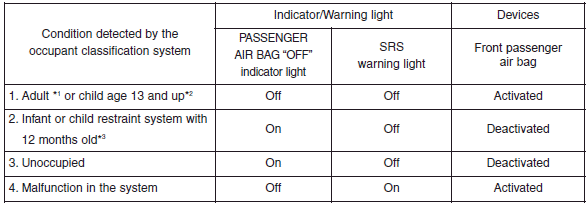
*1) The system judges a person of adult size as an adult. When a smaller adult
sits in the front passenger seat, the system may recognize him/her as a child depending
on his/her physique and posture.
*2) Do not allow children to ride in the front passenger seat. When a larger child
who has outgrown a child restraint system sits in the front passenger seat, the
system may recognize him/her as an adult depending upon his/her physique or sitting
position.
*3) Never install a child restraint system on the front passenger seat.
WARNING
Riding in an improper position or placing weight on the front passenger's seat when it is unoccupied by a passenger adversely affects the occupant classification system (OCS).
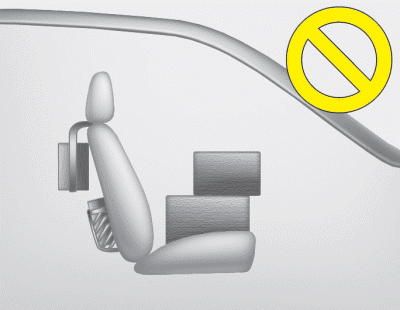
- Never put a heavy load in the front passenger seat or seatback pocket.
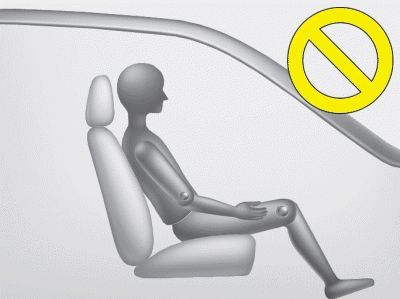
- Never sit with hips shifted towards the front of the seat.
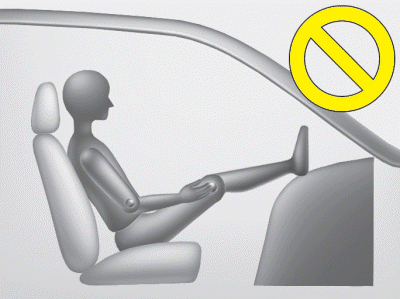
- Never place feet on the dashboard.
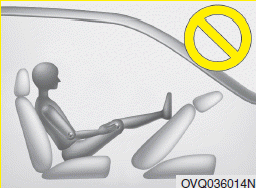
- Never place feet on the front passenger seatback.
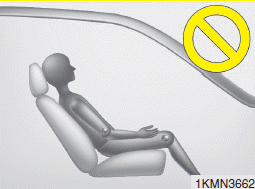
- Never excessively recline the front passenger seatback.
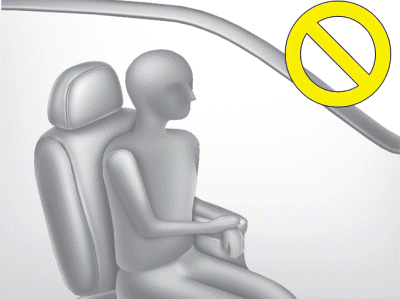
- Never lean on the door or center console.
- Never sit on one side of the front passenger seat.
Proper position
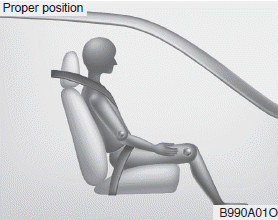
When an adult is seated in the front passenger seat, if the PASS AIR BAG “OFF” indicator is on, turn the ignition switch to the LOCK or OFF position and ask the passenger to sit properly (sitting upright with the seat back in an upright position, centered on the seat cushion with their seat belt on, legs comfortably extended and their feet on the floor). Restart the engine and have the person remain in that position. This will allow the system to detect the person and to enable the passenger air bag.
If the PASS AIR BAG "OFF" indicator is still on, ask the passenger to move to the rear seat.
WARNING
Do not allow an adult passenger to ride in the front seat when the PASS AIR BAG “OFF” indicator is illuminated because the air bag will not deploy in the event of a crash. If the PASS AIR BAG "OFF" indicator remains illuminated after the adult passenger repositions themselves properly and the car is restarted, it is recommended that passenger move to the rear seat because the passenger's front air bag will not deploy.
Front seat passengers must stay properly seated to avoid serious injury from a deploying air bag.
✽ NOTICE
The PASS AIR BAG "OFF" indicator illuminates for about 4 seconds after the ignition switch is turned to the ON position or after the engine is started. If the front passenger seat is occupied, the occupant classification sensor will then classify the front passenger after several more seconds.
WARNING
Do not put a heavy load in the front passenger seatback pocket or on the front passenger seat. Do not hang onto the front passenger seat. Do not hang any items, such as a seatback table, on the front passenger seatback. Do not place feet on the front passenger seatback. Do not place any items under the front passenger seat. Any of these could interfere with proper sensor operation.
WARNING
- Even though your vehicle is equipped with the occupant classification system, never install a child restraint system in the front passenger's seat. A deploying air bag can forcefully strike a child resulting in serious injuries or death. Any child age 12 and under should ride in the rear seat. Children too large for child restraints should use the available lap/shoulder belts. No matter what type of crash, children of all ages are safer when restrained in the rear seat.
- If the PASS AIR BAG "OFF" indicator is illuminated when the front passenger's seat is occupied by an adult and he/she sits properly (sitting upright with the seatback in an upright position, centered on the seat cushion with their seat belt on, legs comfortably extended and their feet on the floor), have that person sit in the rear seat.
- Do not modify or replace the front passenger seat. Don't place anything on or attach anything such as a blanket or seat heater to the front passenger seat. This can adversely affect the occupant classification system.
- Do not sit on sharp objects such as tools when occupying the front passenger seat. This can adversely affect the occupant classification system.
- Do not use accessory seat covers on the front seats.
- Accident statistics show that children are safer if they are restrained in the rear, as opposed to the front seat. It is recommended that child restraints be secured in a rear seat, including an infant riding in a rear-facing infant seat, a child riding in a forward- facing child seat and an older child riding in a booster seat.
- Air bags can only be used once – have an authorized HYUNDAI dealer replace the air bag immediately after deployment.
- The occupant classification system may not work properly if water, coffee or any other liquid including rain gets on the seat. Keep the front seat dry at all times.
- Do not place an electronic device such as a laptop computer on the front passenger seat. Its electronic field may cause the OCS to switch to the "on" condition and thus allow the passenger air bag to deploy needlessly in a collision, increasing your repair costs.
- A smaller-stature adult in the front passenger’ seat who is not seated
correctly (for example: seat excessively reclined, leaning on the door or center
console, or hips shifted forward in the seat) can cause a condition where the
occupant classification system senses less weight than if the occupant were
seated properly (sitting upright with the seatback in an upright position, centered
on the seat cushion with their seat belt on, legs comfortably extended and their
feet on the floor).
This condition can result in an adult potentially being misclassified as a child and illumination of the PASS AIR BAG "OFF" indicator.
WARNING
If the occupant classification system is not working properly, the SRS air bag
warning light  on the instrument
panel will illuminate because the passenger's front air bag is connected with the
occupant classification system. If there is a malfunction of the occupant classification
system, the PASS AIR BAG "OFF" indicator will not illuminate and the passenger's
front air bag will inflate in frontal impact crashes even if there is no occupant
in the front passenger's seat. If the SRS air bag warning light does not illuminate
when the ignition switch is turned to the ON position, remains illuminated after
approximately 6 seconds when the ignition switch is turned to the ON position, or
if it illuminates while the vehicle is being driven, have an authorized HYUNDAI
dealer inspect the occupant classification system and the SRS air bag system as
soon as possible.
on the instrument
panel will illuminate because the passenger's front air bag is connected with the
occupant classification system. If there is a malfunction of the occupant classification
system, the PASS AIR BAG "OFF" indicator will not illuminate and the passenger's
front air bag will inflate in frontal impact crashes even if there is no occupant
in the front passenger's seat. If the SRS air bag warning light does not illuminate
when the ignition switch is turned to the ON position, remains illuminated after
approximately 6 seconds when the ignition switch is turned to the ON position, or
if it illuminates while the vehicle is being driven, have an authorized HYUNDAI
dealer inspect the occupant classification system and the SRS air bag system as
soon as possible.
 Occupant classification system
Occupant classification system
Type A
Type B
Your vehicle is equipped with an occupant classification system in the front
passenger's seat.
The occupant classification system is designed to detect the presence of a ...
 Driver's and passenger's front air bag
Driver's and passenger's front air bag
Driver’s front air bag
Your vehicle is equipped with a Supplemental Restraint (Air Bag) System and lap/shoulder
belts at both the driver and passenger seating positions. The indications of th ...
See also:
Engine compartment
■ 2.4 GDI
1. Engine coolant reservoir
2. Engine oil filler cap
3. Brake/clutch fluid reservoir
4. Air cleaner
5. Fuse box
6. Positive battery terminal
7. Negative battery terminal
8. W ...
Front Strut Assembly. Components and Components Location
Components
1. Insulator cap
2. Insulator assembly
3. Strut bearing
4. Spring upper seat
5. Spring upper pad
6. Coil spring
7. Spring lower pad
8. Dust ...
Special Service Tools
Special Service Tools
Tools
(Number and Name)
Illustration
Use
09411-1P000
Clutch disc guide
Installation of the ...
